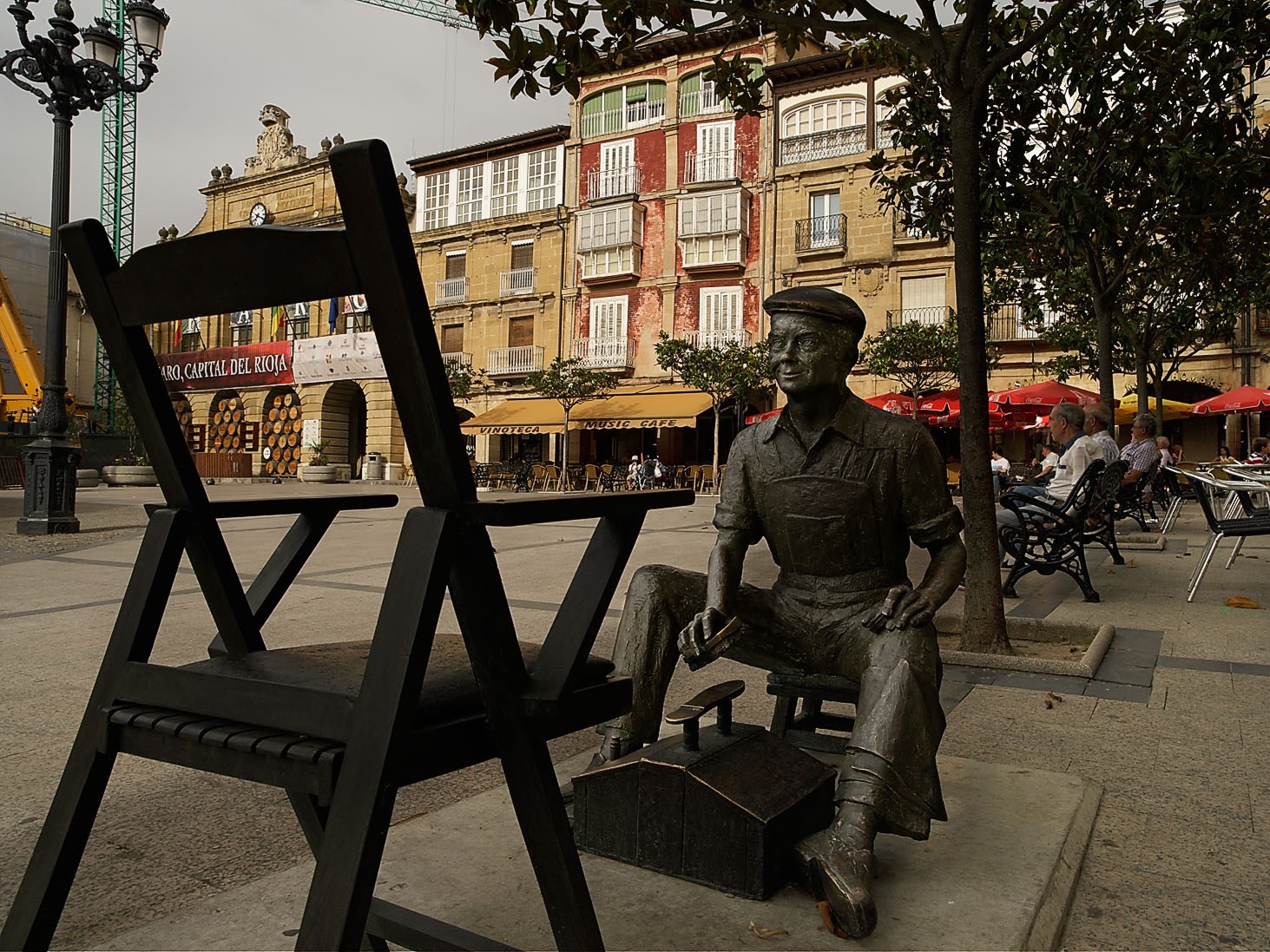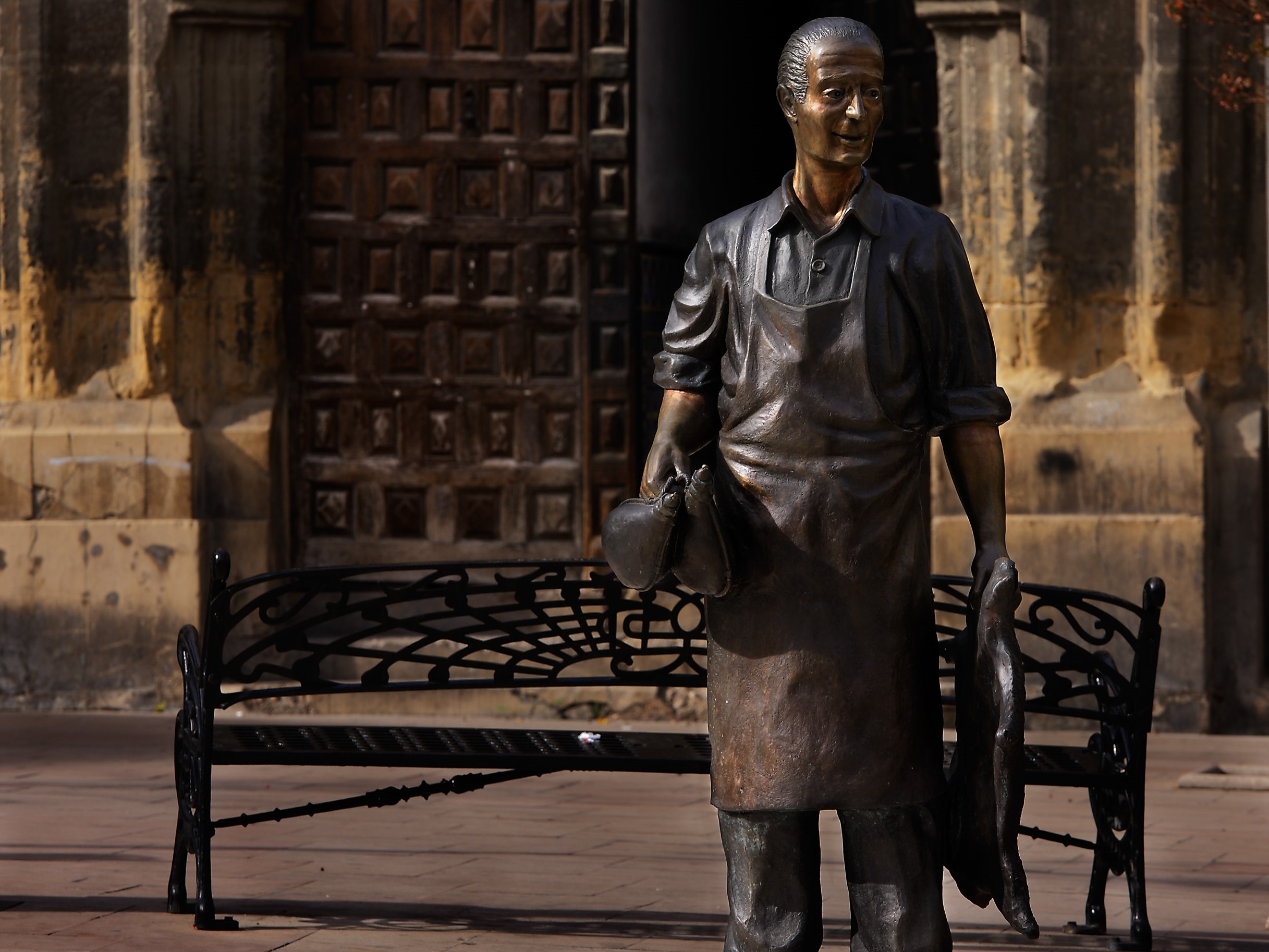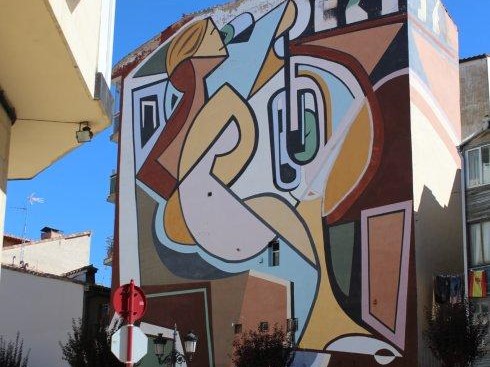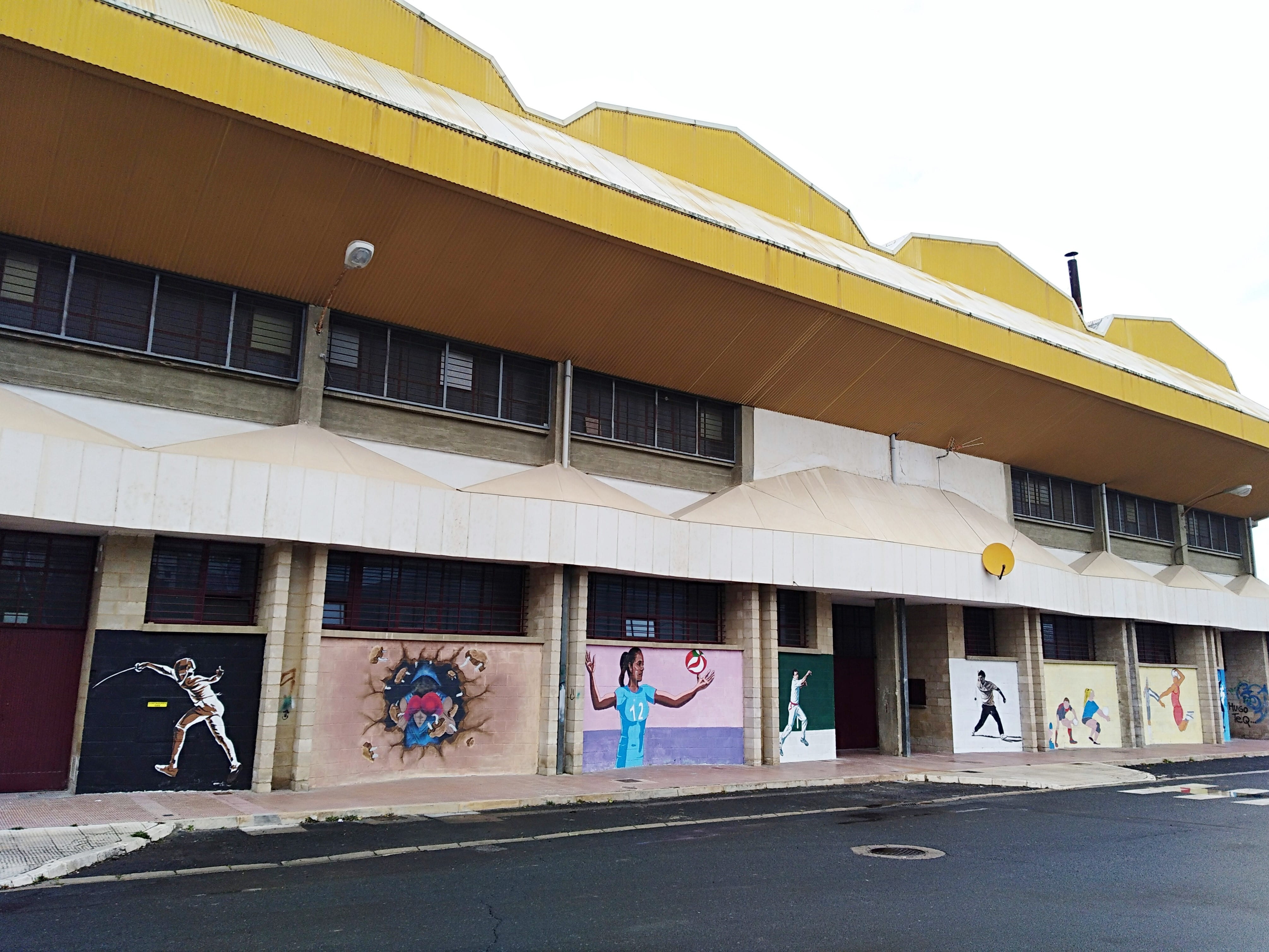Open Air
Sculptures
Art and Crafts from HaroFor a long time, the men and women of Haro have been involved in the tasks and tasks of viticulture and winemaking, in a territory where the vineyard is the crop par excellence.
On your journey through this open-air museum, you can see different sculptures of traditional, artisan and artistic trades, with which you can recognise the work, in some cases now extinct, of many people who lived and worked in Haro and in the Rioja Alta.
Alpargatero
Anselmo Iglesias Poli, 2009In the shadow of the important espadrille factories that existed in Haro, a considerable number of residents also made them on a small scale. These craftsmen, who usually settled in enclaves protected from the weather, used a small table for their work, with a built-in seat, on which a wooden pivot protruded, where the esparto grass sole was supported to apply, with an awl or a punch, a strong stitching with jute yarn. The rest of the utensils, the scissors and a finer needle, were used to cut the fabric and finish it off by sewing it to the sole. The guild of espadrilles had an important weight in the city until almost the middle of the 20th century, and several strikes were organised in defence of their rights.
Embotellador / Encorchador
Teodoro Antonio Ruiz, 2009When the time came for the wine to leave the barrel and occupy the bottle in order to achieve its optimum fineness before marketing, two important tasks fell to the winery's most experienced employees. One was the bottling, at the time ordered by the master winemaker, to avoid any kind of decantation, taking into account the level of liquid bottled, since the second consisted of the corking, which, in order to avoid losses and wasting time, needed the uniformity and meticulous measure of the first. Work which, in those years, involved remaining in a sedentary position, for many hours, on benches that were not really notable for their comfort.
Shoe shiner
Santiago de Santiago, 2009Among the many professions generated by the buoyant Haro’s economy of the late nineteenth century, the profession of the shoe shiner must also be noted. It was at that time that the elegantly dressed citizens attended the numerous events that took place in the city, so many regulars visited the shoe cleaner with the intention of showing off the shoes well polished. To carry out his work, the shoe cleaner used a box, usually made of polished wood, with a support to support the shoe sole, keeping inside protectors for the socks, several luster jars of different colors, various brushes, to apply it and shine, and the bayettes with which it achieved a spectacular result. After the years, at the end of the twentieth century, the image of the popular shoe shiner had already disappeared, so perhaps this representation is the only image we can observe from this profession.
Hortelana
Ángel Gil Cuevas, 2009From time immemorial, and to supplement the income produced by work in the winery, many tracks were exploited by the locals. Their products were of the highest quality and were brought for sale by market gardeners who stayed in this part of the town where there was a market place and where the open-air market is still held today. These women, like the one we see in this sculpture, were always the genuine representatives of the Plaza de la verdura, so called at the beginning of the 20th century. They became so appreciated and considered that they became the protagonists of a localist sainete called "Vega la Jarrera".
Vinatero
Anselmo Iglesias Poli, 2009It was a little over two decades before the end of the 19th century, when an appreciable number of retailers and small wine producers, taking advantage of the shortage of taverns, set up their offices or shops in the doorways of their homes, corners and strategic passages of the town. Their working tools were few and simple, such as carafes in which they transported the wine and a funnel for transferring it to the bottle, if the customer so wished, instead of consuming the classic jug. These improvised tavern keepers had the competition of numerous wine sellers who were distributed in the old town, today La Herradura, offering their product also in small clay jugs. This custom had become so deeply rooted in the haras that, in not too long, they would be baptised by outsiders with the name of. "Jarreros".
Botero
Ángel Gil Cuevas, 2009The need for a container to transport liquids, especially wine and oil, led to the appearance, many centuries ago, of the "odreros", artisans who worked, preferably, the skin of the goat to make wineskins, better known in our area as "pellejos de vino" (wine skins). The incursion of French winemakers into our region led to the use of barrels for transporting wine, so that during the second half of the 19th century the coopers displaced the millers who became better known as boteros, as their activity specialised in the manufacture of the typical leather wineskin, essential for any party or pilgrimage.
Tonelero
Cándido Pazos, 2009Late in the second half of the 19th century, the cooperage, a trade that had come from the Bordeaux winemakers who settled in our town, acquired extraordinary importance, as the 220 litre barrel was the preferred container for transporting wine. For many years, this work was in such great demand that, as there were not enough Haro coopers to produce the necessary barrels, many riverside carpenters from the ports of Bermeo, Lekeitio, Ondarroa... came to our town to settle in such a well-paid trade. Such a profusion of coopers created a spectacular atmosphere, both visually, because of the lively fires that were seen taming the staves, and economically, as some of them boasted so much of their income that they even went so far as to light their cigars with paper money.
Músico
Teodoro Antonio Ruiz, 2009The economic boom generated by the price of wine increased the cultural needs of a large part of the population, with the musical arts undoubtedly being the most sought-after. This elegant musician who plays the horn seems to have been taken from one of the Haro music bands that, perfectly organised and dressed, had been playing since 1840. They were the musicians of the Haro battalion militia, led by Mr. Gabriel Rivera, who, at the end of May 1842, played the parades that announced the opening of the Municipal Coliseum, today the Breton Theatre of the Blacksmiths, which we can see just a few metres away.
Tubía and Santamaría Painters park
Miguel Ángel Sainz, 1998This recreational area is located on the edge of the neighborhood of Las Huertas, it was configured at the end of the nineteenth century when the First Avenue was created, currently, Avenue of La Rioja. The land, is completely bounded by the buildings of the town on its east side and by the street of la Ventilla at the South, the neighborhood was acquired by the industrialist Felipe Pérez, who planted the Lebanon cedars, until today, they continue to distinguish it. In 1992 it was transformed into a public park, and was dedicated to the Riojan landscape retratist Jose Maria Tubía Rosales and the brightly colored cubist Jesús Santamaría Azpitarte, perpetuated, since 1998, by Miguel Angel Sáinz Jiménez sculptural work, depicting a painter and his model.
Tribute to the elders
Maria Pilar Gutierrez, 2014The sculpture represents two grandparents with their grandchildren sitting on a bench. An everyday scene in which the grandfather offers a candy to the girl while the grandmother wipes her nose and the youngest boy hugs his grandmother from behind.
Battle of wine
Maria Pilar Gutierrez, 2012Sculpture made in bronze that represents one of the most representative and beloved scenes in Haro. Three characters throwing themselves wine with boots representing what happens every morning on June 29 coinciding with the feast of San Pedro, "The Battle of Wine." Festival declared of National Tourist Interest that consists of soaking other participants with red wine until they are completely purple. The "battle" takes place in the Riscos de Bilibio area, about 6 km away. to the north of the city.
Stepping on grapes
Rotonda Crta. Santo Domingo Calzada. Jesús Pérez Marín “Boregan“, 2006This strong embrace accompanied by a simple barefoot dance, on the grape clusters, was the artisan procedure used to obtain the must that, treated by our winegrowers, gave life to one of the most prestigious wines in the world: RIOJA. Around the same time, and due to its evolution, various trades would emerge that the city of Haro, the cradle and capital of this famous wine, wanted to exhibit through different sculptures located in some of the most welcoming corners of its urban area.
To the vendimiars
Rotonda Julián López Ollero. Jesús Pérez Marín “Boregan”, 2006The effort of the harvesters, since the woman was the main figure of the harvest, and the basket porters with the freshly cut fruit, is reflected in these baskets, brimming with clusters, waiting to be transported to the wineries to become the appreciated wine. The comportas, a type of wooden baskets, characterized by a wider width in its upper part, were for many years the recipients of the product of the vine on its way to the lagares, slowly stopped being used as early as the twentieth century.
Grapes at rest
Avda. Santo Domingo de La Calzada. Cándido Pazos, 2008This sculptural piece welcomes travelers and visitors, is the homage to the winegrowers who, with their effort, have managed to make Rioja wine known and appreciated all over the world. Nothing better than the reproduction of a beautiful bunch of grapes, just like one of those that usually care for and harvest, to capture the excellent quality of our wines.
Monument to the vendimia
Avda. Costa del Vino. Miguel Angel Saínz Jiménez, 2000The animal force (represented by the horse) is guided by the hand of man to illuminate, after the care devoted to the vine, a new wine (represented by the child), which will be pampered and evolved in the winery, represented by the woman who shows her unbeatable achievement in the glass she exhibits in her hand. This wine allegory is surrounded by the famous and centuries-old Haro wineries, or Wine Cathedrals, which since its foundation have carrying and still do, along with the rest of the wineries located in the municipality, the name of the city of Haro on the labels of its bottles, being named and recognized by all the countries that love good wine, HARO CAPITAL OF RIOJA WINE.
Murals
Murals collection made on different facades of Haro; they show images related to the wine world and our city culture, with great diversity of styles and approaches.
Battle of wine
Author: José Uríszar.Mural about the Wine Battle, located in the inner square of Castilla Street (next to the bus station).
Cubist Style
Author: José Uríszar.Cubist style mural. Located in Calle Martínez Lacuesta on the corner of Calle la Ventilla.
The Drunks Customs (The drunks)
Author: Globartia.Made in 2013 for La Rioja Tierra Abierta exhibition.
Reproduction of the Riojan painter Enrique Paternina’s painting, located besides the Palace of Bendaña, in the C/San Martín
Wine Ages
Author: BOREAL IDEA Muralist Company.It represents the ages of wine.
Located in Calle Santa Lucía.
Picture Mural by ADIF
Author: Carlos López Garrido.Located at the top of the ADIF wall, in the historic Barrio de las Bodegas.
It shows an image that reflects the origin of the relevance that Haro has at this time in the world of wine and its culture.
Haro, Rioja wine capital
Author: Desconocido.Located at the end of Rioja Palomar Street, it can be seen from the El Ferial Sports Centre.
Bacus Mural
Author: Desconocido.Located in Calle Tenerías, next to the Jardines de la Vega.
Uraban Tribe
Author: José Uriszar.Located in the Plaza José Ruiz Extremiana "El Feo".
It represents all the urban tribes, all the kind of people that can be gathered in this place of Haro.
Tourism Office Mural
Author: José Uríszar.Draft Murals
Author: José Uríszar.Putting grapes in the draft
Author: José Uríszar.Mural Sala Faro. Cultural Municipal Center.
Author: Desconocido.Old Library San Millán de la Cogolla
Public Library Mural
Author: Desconocido.Suso Monastery































